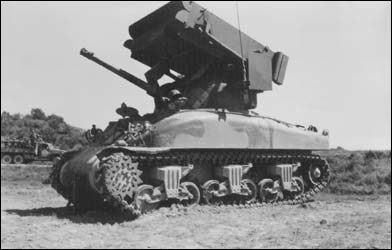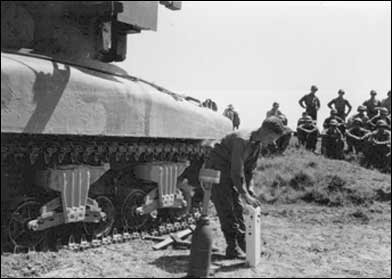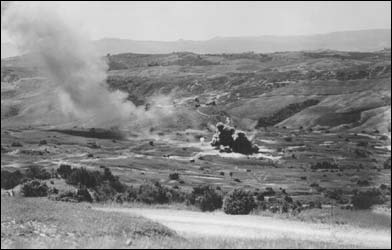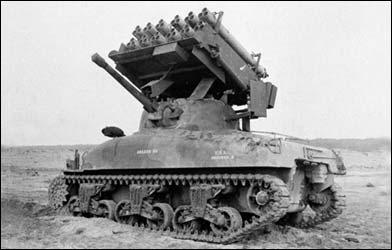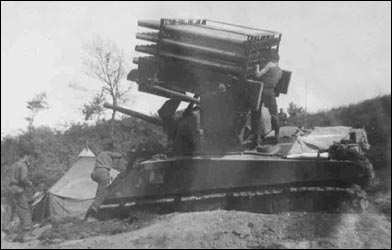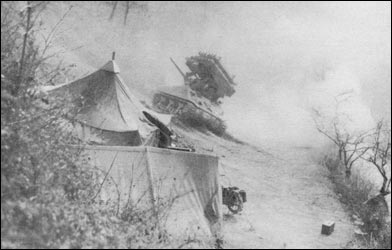Rocket
Tanks in the 752nd Tank Battalion
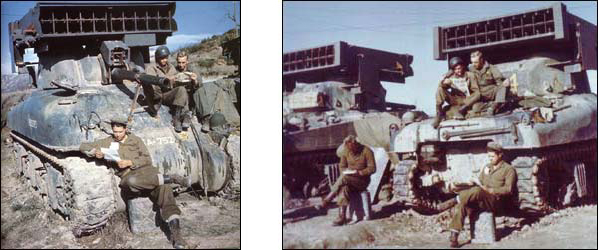
Men of B Company's 3rd Platoon relax beside their rocket tanks. These tanks, an M4 and an M4A1, are equipped with
the experimental T40 Rocket Launcher. At the time these photos were taken, the tanks had not yet been used in combat.
- Researched and Written by Robert J. Holt -
The 752nd was one of the first tank battalions in the MTO to experiment with rocket tanks, and at one time maintained one of only two Rocket Tank Platoons in all of II Corps.
In 1944, the Army Ordnance Department began developing several different types of tank mounted rocket launchers. In large part, the development of the rocket tanks was inspired by the German “Nebelwerfer,” which was a rocket gun mounted on a halftrack. Nebelwerfers, nicknamed “Screaming Meemies,” instilled considerable fear among Allied foot soldiers given their high saturation of fire and the unmistakable “screaming” noise made by the incoming rockets.
The US tank-mounted rocket launchers were designed to hit enemy defenses with a high density of fire in advance of an attack. The intent was to use these “rocket tanks” against area targets rather than point targets, given the inaccuracy that was inherent in the weapon. In 1944 and 1945, the US designed some 12 variants of the tank mounted rocket launcher: the T34/T34E1/T34E2 series (series standardized as the M8 Calliope), the T39/T40/T40 Short Version (series standardized as the M17), the T72 (standardized as the M16), and the T73, T76, T76E1, T105, and T99 series. Not all of these versions saw combat. Of the ones that did, the T34/M8 “Calliope” was the most widely used, with the earliest reported use in the Normandy Campaign in June 1944. Even more rocket tanks were developed for non-combat engineering roles, such as the T31 Rocket Demolition Tank.
On 5 August 1944, the 752nd Tank Battalion was ordered by II Corps Headquarters to turn over 4 tanks to the 529th Ordnance Battalion. These tanks, along with four others from the 760th Tank Battalion, were put aboard tank transporters and moved to Rosignano, where they were outfitted with the highly experimental T40 rocket launcher. Platoon leaders, tank commanders, and drivers were to accompany the tanks and remain at the 529th Ordnance Battalion during the installation. Tank gunners and assistant gunners were summoned after installation.
This was a top secret project, as indicated in the 5 August orders:
“Special attention will be paid to secrecy. All discussion of the matter except with those directly concerned will be avoided. During the installation, practice, and transport of the tanks, the launchers will be kept covered except while actually in use, at which time only authorized persons will be permitted to witness its installation or use.”
Four days later, (9 August 1944), the rocket launchers had been successfully installed on all eight tanks. Technical training had already begun on 8 August 1944, and the crews were reported as “enthusiastic.” 681 rounds of 7.2 inch ammunition were procured for test firing at an unspecified later date.
On 10 August, the 88th Infantry informed II Corps that they wanted to turn over the four tanks that were under their control to the 760th Tank Battalion. The 88th had been very cool toward the use of these tanks ever since they learned that the maximum range was only 230 yards. The G-3 of the 85th Infantry was far more positive toward the weapon, and while he seriously questioned why the weapon had such a limited range, he wanted to keep the tanks under his control. According to the II Corps documents, Colonel Bruss of the 752nd Tank Battalion (which was attached to the 85th Infantry at the time) was the most interested of all principal parties. Colonel Bruss was so interested in the rocket tanks that he had already gone ahead and had his S-3 designate a training area. This area was in a small valley just south of Scansano, to the east of Volterra.
Bruss requested an immediate test firing to give him “some idea of the capabilities of the weapon.” The II Corps captain who was in charge of the rocket tank program quickly agreed to the test firing, figuring that a demonstration of the capabilities would sway the opinions of those who remained skeptical about the rocket launcher’s capabilities. A total of 47 officers were invited, but it is not known how many actually attended. Colonel Bruss had chosen the men of B Company’s 3rd Platoon to train on the rocket tanks, and of course enlisted men from this platoon were present for the test firing exercise. All eight rocket tanks were shipped via tank transporters to the 752nd test firing area later that day (10 August).
There is no written documentation regarding the results of the test firing, other than a brief memo stating that the demonstration was to begin at 1430 hours on 12 August. The Signal Corps photographic records confirm that the test firing was conducted on 12 August 1944, with several men and officers observing. A training demonstration was conducted by 2nd Lt. T. L. Collins of the Ordnance Section of AFHQ prior to the actual test firing. Lt. Collins was one of only two "War Department authorities in the theater."A good side view of one of the 752nd T40 Rocket Tanks, just prior to the initial demonstration and test firing that took place on 12 August 1944. The name "Bishop" is stenciled in tiny letters on the dark camouflage spot on the middle of the sponson. The 2 ton truck in the background is transporting some of the observers to the site, which had been closed to all other traffic.
Lt. Collins had helped design the training and demonstration program for the rocket tank crews, along with Captain William R. Barret of II Corps (who was responsible for the II Corps rocket tank implementation). This training program included Technical Training on the characteristics and capabilities of the weapon, as well as mechanical training, technique of fire, and practice training. The program also included Tactical Training, which included reconnoitering of routes to firing areas, targets, probable firing missions, displacement, river crossings, and pillbox reduction.2nd Lt. T. L. Collins demonstrates the firing control box on 12 August 1944, prior to the test firing. The firing control box was mounted on the inside of the lower rear of the turret. A completely assembeled 7.2 inch rocket round appears in the foreground.
Men of the 752nd load the 7.2 inch rockets as part of the Technical Training phase immediately prior to the initial test firing demonstration that was held on 12 August 1944. The rockets were loaded into the front of the launcher, and each rocket was then individually wired from the rear of the launcher.
Without any surviving written documentation, it is not officially known how the 752nd “brass” felt about the weapon immediately after the test firing demonstration. However, a journal entry in the diary of Sgt. Raymond Holt on the day of the demonstration succinctly sums up an enlisted man’s view of the experience: “Aug. 12 – Fired new gun but it isn’t any good.”
A rocket salvo fired by the above M4A1 finds its mark during the initial test firing on 12 August 1944. Captured German tanks explode when hit by the rocket barrage at a range of approximately 200 yards. The rockets left the plume of smoke which begins at the upper left corner of the photo.
During the night of 15 August, the eight experimental rocket tanks and their crews were transported to the 760th Tank Battalion bivouac area for completion of training. By 19 August, the 760th Executive Officer told II Corps Headquarters that he would “very much like to get rid of the tanks.” His complaints were that the tanks immobilized an entire platoon, which he felt were better used in conventional tanks, that the limitations of the weapon more than counter-balanced its merits, and that “the tank crews were unfavorably impressed with the weapon.” The 760th XO elaborated by saying that his crews felt particularly uneasy about the T40 because it obstructed the turret hatches, and would therefore trap the three men in the turret if the tank was hit.
Upon receiving the 760th report, II Corps detached the eight tanks from the 760th Tank Battalion, which was moving to a forward area, and shipped them to the 755th and 757th Tank Battalions for training. The previously trained crews from the 752nd were assigned to the 755th (under 91st Infantry control), and the trained crews of the 760th were assigned to the 757th (under 34th Infantry control). The tanks and crews arrived for training in their respective areas on 29 August 1944.
Following this round of training, both Infantry Divisions expressed interest in using the rocket tanks in the “upcoming attack” (presumably the attack on the Gothic Line). The 34th Infantry intended to attach its tanks to the 757th Tank Battalion and use the rocket tanks in the manner for which they were intended. However, the 91st infantry G-3 said they would attach its rocket tanks to its Division Artillery. Both Division G-3s, however, viewed the weapon’s limited range as a “limiting factor,” according to the II Corps report, and were quick to point out that they could not guarantee how if at all the tanks would be deployed once the attack was underway. Sensing a lack of commitment, the captain in charge of the II Corps rocket tank program felt that “You Will” orders would be required to ensure that the tanks would in fact be used.
The 752nd’s CO, Colonel Bruss, told II Corps on 29 August that he had “originally placed his best tank crews on the tanks to be launcher mounted.” Since the 752nd was attached to the 85th Infantry at the time (not the 34th or 91st, where the rocket tanks were assigned), Bruss felt that continued use of his valued tank crews in the rocket training program was no longer justified. So Bruss informed II Corps that he “needed his good men and was taking them, substituting another tank crew.” In taking this action, Bruss provided the rocket program with the benefit of “training two-deep,” which II Corps viewed very favorably. In this regard, the 752nd arguably became II Corps' best-trained armored unit in the use of rocket tanks.
There is no further written documentation regarding the use of the eight T40 tanks in combat around the time of the attack on the Gothic Line. Based on a few intentionally cryptic comments in V-mails, it does appear that the tanks saw at least some limited action in the fall of 1944. Two 3rd Platoon vets sent V-mails to a wounded buddy who was recovering in a hospital. One V-mail states only that the 3rd Platoon got “called back to their Buck Rogers,” and the other V-mail states that “our platoon is playing Buck Rogers again.” “Buck Rogers” refers to the rocket-flying comic book character that was popular during the war.
After gaining experience with the weapons in the field, the 752nd tankers generally did not like the rocket tanks because they had too short a range, took too long to prepare, and were top-heavy and cumbersome in the Italian mountain terrain. Last but certainly not least, they tended to draw a lot of enemy fire.
It is assumed that the 7.2 inch T40 rocket launchers were generally considered unsatisfactory, because by 24 October 1944 the 752nd began receiving information about the T34 4.5 inch 60-tube rocket launcher, which had already been in use in France and Germany. The T34 “Calliope” had several advantages over the T40, including a greatly improved range, lighter weight, and better access to turret hatches. A test firing of a tank-mounted 4.5 inch rocket launcher was conducted on 17-18 December 1944 near Viareggio, Italy (See photo of this rocket tank below).
A week later, on 26 December 1944, all eight of the original 7.2 inch T40 tanks were being refitted with 4.5 inch T34 rocket launchers. Four of these eight refitted rocket tanks were assigned to the 752nd Tank Battalion, and the remaining four were shipped to the 760th Tank Battalion. All four of the 752nd's rocket tanks remained with the battalion almost through the end of the war, and were incremental to the 752nd's normal complement of medium tanks.
Interestingly, these rocket launchers were not the standard 60-tube Calliope launchers, but instead were custom manufactured in-theater (at Barberino, Italy) by the 525th Ordnance Battalion. While these launchers used the same basic design and ammunition as the T34 Calliope, they were actually highly customized, using materials that were available in-theater.
Based on II Corps documents, these rocket launchers appear to have been improvised out of aircraft rocket tubes that were in plentiful supply in the Willow Run Ordnance Plant in Florence, Italy. These tubes were originally manufactured for suspension under aircraft wings, and came in sets of three. At the time of the experiment, some 10,000 rounds of 4.5 inch rocket ammunition were in supply in the Italian theater, so ammunition would be in relatively good supply if the experiment proved successful. Several technical documents, memos, and photos indicate that these launchers had 54 tubes instead of the standard 60 tubes that were used on the T34 Calliope and its variants.
The eight initial 4.5 inch rocket tanks used at least two different configurations of the 54-tube arrangement. One configuration known to have been used on one of the 760th Tank Battalion launchers used three rows of 6 clusters of 3 tubes per cluster. The lower armored base of the old T40 Launcher was retained, with the lower row of clusters mounted just above this base.
At least one of the original eight rocket tanks was configured with 3 rows of 6 clusters of 3 tubes per cluster. Note the lower armor plating from the old T40 unit. Photo taken at Viareggio on 19 December 1944, just a day after the firing demonstration. This tank, named "Arlene III," bore Registration Number 3058580-S and was attached to the 760th Tank Battalion. This was the first of the eight rocket tanks to be fitted with the 4.5 inch rockets.
The second type of configuration was used on at least one 752nd tank, and perhaps on 7 of the 8 experimental rocket tanks. This was a 4-row configuration, with wider spacing between the rows than what was used on the standard T34 Calliope. While the exact arrangement of the tubes is not known, a logical 54-tube arrangement for a four-row rack would have been either two rows of 15 on the top and two rows of 12 on the bottom, or perhaps 14 on the top 3 rows and 12 on the bottom row. It appears that the lower armor plating of the T40 was also retained on this version. (see following photo)
The 752nd first fired its 4.5 inch rocket launchers sometime in early January 1945, while the tanks were technically under 91st Infantry Division control. On 11 January the rocket tanks rejoined the 752nd, and were used on a somewhat regular basis during the static Northern Apennines campaign. On 9 February 1945, Colonel Bruss filed a less than positive report entitled “Combat Effectiveness of Rocket Projectors Mounted on Tanks, Medium, M4” and submitted it to General Bolte, commander of the 34th Infantry Division. In this report, Bruss cited several limitations of the 4.5 inch rocket tanks in his battalion.
First, he stated that the launcher’s added weight makes the vehicle “cumbersome and unwieldy” to drive, and that the extra weight caused the tank to slip and slide in conditions where a regular tank would not. Bruss also noted that the launcher's height caused “a great deal of snagging of tree limbs and strung wire.” This required the constant supervision of a spotter, which was considered a real liability in forward areas.
Colonel Bruss went on to respectfully complain that in order to reach the maximum range, the tank could not fire from a level position. Instead, a 2 foot deep by 3 foot wide trench had to be dug for one track of the tank. In this position, the turret was traversed to a right angle to the trench and raised to maximum elevation. If the tank needed to fire in a different direction, a new trench needed to be dug. The slant of the tank in this position was such that it was nearly impossible to boresight the center tubes on the aiming stakes that were provided. The 752nd solved this problem in-field by lengthening the aiming stake to 20 feet. Bruss made a recommendation that the launcher be modified to eliminate the need to dig in one side of the tank.
A crew member wires the tubes on one of the 752nd's 4.5 inch rocket launchers. Note the non-standard spacing between the tube rows. The track in the foreground has been dug-in to provide greater elevation. When the crew member completes the wiring, the turret will be traversed 90 degrees to its right for firing.
In his report, Bruss also stated that it took a crew of 5 men approximately two hours to unpack the rockets, load the 54 tubes, and wire the launcher. With this kind of time investment, plus the digging of trenches, the rocket tanks could only realistically be employed in static situations.
The results of the initial combat firing, according to Bruss’s special report, appear to have been effective. His report stated that “no erratic rounds were observed,” “buildings were generally damaged,” and “one out building was seen to be completely demolished.” In describing the firing, Bruss noted that:
“the effect was comparable to German Nebelwerfer fire without the siren whistle sound. The accompanying sound of this rocket does not have the desired anti-personnel morale shaking feature.”
Interestingly, there had been a great deal of interest in achieving the same whistling effect as the German Nebelwerfer. In fact, in a test conducted on 4 December by II Corps using a truck-mounted 4.5 inch launcher, a "whistling attachment" had been installed on the rounds. However, the report indicates that "Whistle attachment produced no effect at firing point and was not heard by range guards 2000 yards in front." The desired sound never was achieved in subsequent variants.
The rocket tanks of the 752nd saw continuous action for the first time in early March 1945, firing almost steadily for a 12 day period. In the 752nd Narrative Report for March 1945, Major Woodbury writes about the rocket tank missions during that month:
“Target area on all targets, was exceedingly well covered. Air OP and ground OP reported targets ‘well covered’, ‘beautiful coverage’, and ‘just where we want them.’ Results of this rocket fire were very good and added greatly in keeping enemy harassing fire down. Enemy OP’s and gun positions were blown out time and again and in some cases have not been replaced.”
The effects of an on-target rocket barrage were quite devastating. On 4 March 1945 at 1640 hours, a single rocket tank of the 752nd fired at an abbey at Monte Armato that was being used by German observers. The terrain blocked the tankers' view of the abbey, so they employed indirect firing methods using coordinates provided by their own forward observers. Records show that this tank fired a salvo of 53 rockets from a measured distance of approximately 3,800 yards. The rockets scored a direct hit on the abbey, with the results described by the photos and caption below.
The abbey on Monte Armato, originally built in 1129 AD. Left to right, it is shown before the war in 1939, shortly after its destruction in 1945, and after its reconstruction in 1972. The attack destroyed many irreplaceable religious, historical, and cultural items. Romanesque sculptures were crumbled, and 14th century frescos were smashed. Two sides of the top of the small bell-tower were completely blown away. The abbey's prized bell, smelted by Rolando in 1351, was cut into two pieces, and one of the pieces remained suspended from the tangled roof beams for many years afterward. Photos by Italian photographer Luigi Fantini.
The rocket tanks of the 752nd saw increasingly heavy use in early April 1945, as the Fifth Army prepared for the Spring Offensive. The 752nd last used its rockets tanks on 19 April 1945, when the front lines had advanced to the point where it was impossible for them to provide effective support. Following the static winter months, the situation as of mid-April was far too fast moving and fluid for the rocket tanks to be employed. The four rocket tanks were removed from the 752's equipment inventory on 26 April 1945, just hours before the battalion’s medium tank companies crossed the Po River.
Though the 752nd's
official records are less than complete, they do show that at
least
3,470 4.5 inch rockets were fired between 2 February and 19 April 1945.
This amounts to 867 rounds or 16 full salvos per tank, and accounts for
roughly 35% of all of the 4.5 inch rocket ammunition that was normally
on hand in-theater to supply both the Army and the Army Air Corps.
A 752nd 4.5 inch rocket tank fires at targets on Hill 363 during the first week of March 1945. Despite the steep slope, the tank's left (downslope) track still appears to have been dug in. Note how top-heavy the tank looks in the mountainous terrain. The 752's four rocket tanks were widely dispersed, with each firing on different target areas. It is quite possible that this is the same salvo that destroyed the abbey at Monte Armato (as described in the caption for the prior photo).
(Sourced From II Corps Documents)
7.2 Inch T40 Rocket Launcher:Weight of Launcher: 5,500 lbs empty, 6,700 lbs fully loaded Tubes: (20) 90-inch tubes, 2 rows of 10 Tube Material: Sheet steel Life of Tubes: Indefinite Firing Method: Electrical, single-shot or ripple fire Maximum Firing Rate: 20 rounds in 10 seconds (ripple fire) Muzzle Velocity: 160 feet per second Maximum Range: 230 Yards Effective Range: Typically 60-75 Yards Rocket Type: 7.2 Inch High Explosive Rocket T37 with circular fins Rocket Dimensions: 61 lbs, 35 inches long Explosive Charge: 32 lbs of C2 plastic explosive Laying on Target: By turret gun sight Traverse and Elevation: Traverse by turret, elevation by main gun Main Gun Operation: Can be fired with launcher installed Jettison Capability: Hydraulically jettisoned in seconds Armor Plating: Will divert up to .30 caliber bullet 4.5 Inch T34 Rocket Launcher (Standard 60-Tube Unit):
Weight of Launcher: 1840 lbs empty, 4240 lbs fully loaded Tubes: (60) 90-inch tubes, 2 rows of 18 on top, 2 rows of 12 on bottom Tube Material: Plastic Life of Tubes: Begin breaking up after 4 salvos, average life 15 to 20 salvos Firing Method: Electrical, single-shot or ripple fire Maximum Firing Rate: 60 rounds in 30 seconds (ripple fire) Muzzle Velocity: 850 feet per second Maximum Range: 4,600 Yards Effective Range: 3,900 Yards Rocket Type: 4.5 Inch Aircraft Rocket with folded fins Rocket Dimensions: 40 lbs, 33 inches long, fin-stabilized Weight of projectile in flight: 15.25 Lbs Rocket Flame: 30 to 40 feet Explosive Charge: 4.3 lbs of TNT explosive Conventional Blast Equivalent: 105mm shell Laying on Target: By turret gun sight Traverse and Elevation: Traverse by turret, elevation by main gun Main Gun Operation: Cannot be fired until launcher is jettisoned Jettison Capability: Hydraulically jettisoned in seconds Armor plating: None
Researched and Written by Robert J. Holt
Page Content Copyright 2003 - 2025 Robert J. Holt
All Rights Reserved
